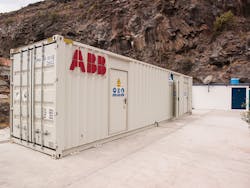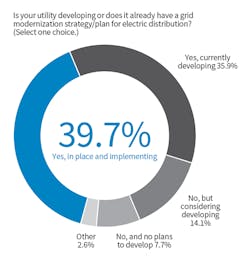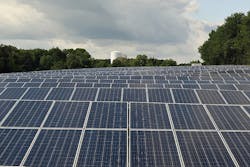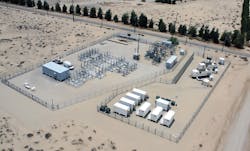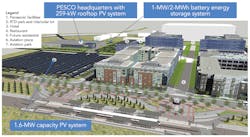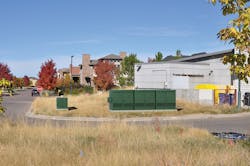There has been a lot of discussion lately about the grid modernization taking place in the power-delivery industry. Grid modernization seems to be the latest catch-all phrase, covering a lot of different subjects. Depending on who is talking, the focus might be on replacing infrastructure or improving the power system’s efficiency. Perhaps the expert is interested in reducing carbon footprints or adding newer smart grid technologies; the list goes on. When all the rhetoric on grid modernization is reviewed and boiled down, it is quite simple: A more dynamic and flexible grid is needed to meet the needs of the 21st century.
Fortunately, the stakeholders of the power grid committed to this many years ago when they planted the seeds of modernization by deploying a lot of digital technologies on the grid. The size and complexity of the legacy grid makes modernization an enormous challenge, but these advanced technologies are making it possible. Technologies are in place that make possible smart platforms such as real-time dynamic monitoring, diagnostics with predictive analytics, decision-making asset management systems and next-generation dispatchable renewable resources.
Transformational Technologies
Cutting-edge technologies are being combined to deliver game-changing disrupters no one could have anticipated, as the grid expands from an electricity supplier to an energy-service platform and consumers become prosumers. The word "transformational" keeps popping up in papers and discussions. These extraordinary technologies are transforming electric utilities’ conventional business models into unconventional business strategies that are blurring the distinction between producers, distributors and customers. They are transforming the generation resources mix, too, by using less coal and nuclear as well as more wind, solar and natural gas.
In turn, this opened the door for distributed energy resource (DER) systems, which many gurus proclaim is the biggest accelerator of the grid modernization undertaking. The original DER concept was simple. Small energy sources — such as gasoline or diesel generators, rooftop solar and fuel cells — were placed on the customer’s side of the meter to keep their lights on or reduce their electric bill. From that starting point, DER has grown over the years and morphed into a wide array of digital technologies now referred to as DER systems.
These systems include generation devices, monitoring systems, control schemes and energy storage systems (ESS), which enable greater real-time responsiveness in connecting power producers and consumers. When these individual schemes are combined, they become more than the sum of their parts. They also become more complicated. Although it is not rocket science, it does require a better understanding of the technology and what the user is trying to accomplish. It could be said what makes DER systems valuable in the grid modernization process is they can be tailored to meet highly specific requirements and applied exactly where needed.
Expectations and Strategies
Every year, Black & Veatch publishes its "Strategic Directions Report," which surveys utility executives on topics of concern and trends taking place in the industry. The 2018 report contains several topics, and grid modernization is one of them. Black & Veatch reports, "The majority of utility respondents (76%) are busy developing grid modernization plans or already have a strategy for electric distribution in place. Of these, 40% already have a grid modernization plan in place and are implementing it, while 36% are in the process of putting theirs together. Of the 24% not currently engaged in grid modernization, more than half are considering it."
Black & Veatch’s study confirms what a lot of authorities are saying: Grid modernization is important to utilities and operators of the grid. Like it or not, modernization is happening, but one takeaway from the study is that DER systems are grabbing interest. This year’s survey revealed 45.8% of the responding utility executives selected the integration of DER systems as a driving element of their plans.
Not only is it important to them, it also is a key factor in their process. This is an important detail because, in the past, DER systems have been connected to the power system, but no one worried about integrating them into the grid’s operation. This may seem like splitting hairs, but it is critical. When the penetration of DER technology increases, it needs to be integrated into the power system to ensure the grid operates as a single entity in real time.
Navigant Research published a report that projects the installed global DER system capacity will reach 530.7 GW by 2024. The report stated, "In many markets, DER deployments are challenging incumbent grid-operating models, requiring a more dynamic network with advanced communications and orchestration to ensure stability, efficiency and equality."
This brings the Black & Veatch survey sharply into focus. To install this amount of capacity requires a large commitment of the owner/operator’s resources. It is one thing to say utilities are focusing on an integration of DER systems, but 530 GW is a very tangible amount.
Several organizations and agencies report the real strength of DER systems is their ability to enable a wide variety of different resources to be matched locally to the load. Being matched locally is significant because authorities like the U.S. Department of Energy (DOE) have been saying, for years, 90% of all electrical power outages take place on the distribution system. Localization of DER/ESS schemes has proven to reduce outages for individual users, which has attracted attention on the distribution side of the grid. It is a short step to apply DER systems to the bulk power side of the grid for that same purpose. It only requires someone to say, "Let’s supersize those DER applications," for the door to open to grid-scale DER schemes as well as the transmission-distribution interface changes.
DERs and Storage
There are many reasons for this transformation. Renewable energy has helped to shift the boundaries, as has the swing from consumers to prosumers, which many of our customers have become. Extreme weather events also have had an impact. Interestingly, it is the influence of weather that has gotten more attention from regulators and customers. When ice storms and hurricanes knock out the power, everyone is upset. This is especially true after a great deal of resources were spent on storm hardening of the power system.
Most groups understand there is only so much technology can do in the face of tornados, fires, floods and other disasters, but they also notice when localized DERs/ESS keep the lights on in these ravaged areas. These small devices have provided critical infrastructure with power that enabled them to continue operation after electricity from the grid went down, which has increased awareness of the DER technology.
Granted, the devices that have gotten most of the attention are microgrids, but they are an important part of the DER family. Microgrids have been defined as smaller-scale versions of the power grid, complete with distributed generation (usually wind or solar), advanced control systems, islanding capabilities and energy storage facilities. In the past, these devices have been small systems located behind the meter, sized for individual customers, but that is changing. The current crop of these schemes has moved to the front of the meter and they are getting larger in scale, which has helped them to gain acceptance by grid owners and operators.
The Kauai Island Utility Cooperative is almost saturated with midday solar power because of the number of solar facilities installed on the island. Consequently, the cooperative installed a 52-MWh lithium-ion (Li-ion) battery on its 13-MW solar farm to enable storage of the solar power. The cooperative recently announced it will be adding another 19.3 MW of solar generation in conjunction with 70 MWh of battery storage, adding to its DER system of residential solar, batteries and controllable loads. This grid-scale DER system provides a time-shifting service for the solar-generated electricity and stabilizes voltage shifts.
The Connecticut Municipal Electric Energy Cooperative (CMEEC) and its partner SolarCity installed several solar facilities, totaling 13 MW with a 1.5-MW/6-MWh Li-ion battery storage system in Bozrah, Norwich and Groton, Connecticut. According to press releases, "The battery storage to be set in Norwich will be integrated with SolarCity’s GridLogic Control technology to allow CMEEC to remotely dispatch stored energy to manage load spikes and optimize the operational efficiency of the network."
These grid-connected DER/ESS projects provide electrical support, flexibility and reliability to CMEEC’s network and make the power supply more secure.
DER Deployment
The shifting of the transmission-distribution interface is not new. It has been taking place for many years. One of the first attention-getters was San Diego Gas & Electric Co.’s (SDG&E’s) Borrego Springs microgrid project. Borrego Springs sits on the end of a radial line that was taken down by a wildfire in 2007. SDG&E built a microgrid for the town, funded by the DOE and the California Energy Commission. The system interconnects with customers’ rooftop solar installations and includes two 1.8-MW diesel generators, with a 500/1500-kWh battery and three smaller 50-kWh batteries.
The system was put to the test in 2013 when severe weather knocked out the transmission line. The microgrid picked up the load for about 24 hours while restoration took place. The DER system was modified in 2015 to connect to a 26-MW solar facility. SDG&E says the project is frequently used as a poster child of energy innovation.
Another project providing hands-on experience with large-scale DER projects is the Ameren Technology Applications Center DER project. Adjacent to the University of Illinois campus in Champaign, Illinois, the project made history in December 2016 as the first utility-scale microgrid to be placed in service in North America. Ameren’s
microgrid operates between 4 kV and 34.5 kV, with multiple levels of control. The Ameren DER project interconnects a solar farm, a wind turbine generator, natural gas generators and battery storage to produce 1475 kW of power.
Ameren’s DER system is controlled by Schneider Electric’s EcoStruxure software. This cloud-based software platform simplifies the integration of DER systems into the grid. The Ameren system uses a 100-kW Northern Power Systems wind turbine, a 125-kW Yingli Solar solar array, two 500-kW Caterpillar Inc. natural gas generators and a 250-kW S&C Electric Co. battery storage system that can supply two hours of electric power.
Recently, Xcel Energy Inc. announced it was installing a large-scale DER system in conjunction with Panasonic Corp. and the Denver International Airport. The project includes a battery storage system located on a feeder with about 30% solar penetration. According to a project spokesperson, "The four primary components of the Panasonic project include a 1.6-MW DC carport solar installation, a 259-kW DC rooftop photovoltaic system at Panasonic’s new corporate facility, a 1-MW/2-MWh Li-ion battery, and switching and control systems to operate the energy storage system and microgrid functionality."
The battery system contains Younicos GmbH’s Y.Cubes, controlled by Younicos’ intelligent Y.Q. storage control software. The DER system provides frequency regulation, solar grid integration through ramp control, and solar time shifting that includes grid peak shaving, energy arbitrage and backup power.
DER Acceptance
These front-of-the-meter DER systems projects are gaining momentum as manufacturers such as ABB, Eaton, General Electric, S&C Electric, Siemens AG and Schneider Electric introduce more advanced DER systems. The result of these efforts is an increasing focus on redefining grid boundaries. An Electric Power Research Institute (EPRI) report on integrating DER systems into the grid said, "Through a combination of technological improvements, policy incentives and consumer choices in technology and service, the role of DER is likely to become more important in the future."
In the report, EPRI stated the real value of DER technologies are the services it offers, but it is made difficult by regulatory policies, procedures and rules. Fortunately, this is changing. Regulators and other stakeholders better understand what DER technologies offer the grid in resilience, security, demand response and efficiency.
The friendlier regulatory climate started several years ago when policy-makers began to change interconnection rules and provide incentives for deploying DER systems. The Federal Energy Regulatory Commission (FERC) has been issuing orders for several years that recognize the value of a DER system with ESS.
With orders 890 and 719, FERC allowed companies installing energy storage technologies to receive compensation. Then in 2011, FERC recognized the value of fast-responding technologies (for example, batteries and flywheels) with order 755. A few years later, in 2013, FERC’s order 784 broadly opened the ancillary service markets to DER/ESS technology. In late 2016, FERC announced a notice of proposed rulemaking to integrate electric storage resources more effectively into organized markets.
However, real progress was made in 2018. On Feb. 15, FERC voted unanimously to remove barriers to the participation of electric storage resources in the capacity, energy and ancillary services markets operated by regional transmission organizations and independent system operators.
In the European Union, the central agencies have no specific regulations or policies formulated on the usage or deployment of DER systems. It has been left to the individual countries to establish their own strategies, which is taking place now. The U.K., Ireland, Germany and Italy are working on establishing a climate friendly to the technology, with directives and framework programs focused on renewable energy penetration and microgrid developments.
In China, the government has developed favorable policies. Its goal is to encourage large-scale development and deployment of renewable energy and distributed generation to promote Chinese DER systems.
This global effort has not gone unnoticed by analysts like Navigant Research. It is predicting the distributed energy storage annual power capacity will rise from 683.9 MW in 2017 to 19,699 MW by 2026. According to the Navigant Research, "Recent market analysis indicates the largest global markets in 2017 (latest available data) would be the U.S., China, Germany, Japan and the U.K."
The growing interest in a more decentralized power-delivery system and the maturing DER systems have had a positive influence on the acceptance of technology.
Basic Engineering
This acceptance increases as DER technologies expand in capabilities and performance abilities, but it is important to know how these systems are evaluated and integrated into the grid. As the technology’s complexity increases, it seems the application of the technology gets harder. However, it still revolves around basic engineering practices. Not all DER systems are created equal. Is a fast response needed or is it better to have a lasting power supply? DER systems can provide energy for a few seconds or many hours. Are large amounts of megawatts needed or would a short burst fit the need best? DER systems can supply a few watts or megawatts.
Therefore, it is critical to understand the problem that needs to be addressed and the abilities of the technology. DER systems supply services to support the grid and provide the customer with dependable power. They can improve power quality and make possible the ability to time-shift generation resources. The industry needs the successful integration of DER systems into the grid. The technology is changing the transmission-distribution interface and moving the industry toward decentralization of the grid. However, it is important to understand DER systems and the power grid are not competing but rather complementary technologies. ♦
About the Author
Gene Wolf
Technical Editor
Gene Wolf has been designing and building substations and other high technology facilities for over 32 years. He received his BSEE from Wichita State University. He received his MSEE from New Mexico State University. He is a registered professional engineer in the states of California and New Mexico. He started his career as a substation engineer for Kansas Gas and Electric, retired as the Principal Engineer of Stations for Public Service Company of New Mexico recently, and founded Lone Wolf Engineering, LLC an engineering consulting company.
Gene is widely recognized as a technical leader in the electric power industry. Gene is a fellow of the IEEE. He is the former Chairman of the IEEE PES T&D Committee. He has held the position of the Chairman of the HVDC & FACTS Subcommittee and membership in many T&D working groups. Gene is also active in renewable energy. He sponsored the formation of the “Integration of Renewable Energy into the Transmission & Distribution Grids” subcommittee and the “Intelligent Grid Transmission and Distribution” subcommittee within the Transmission and Distribution committee.
